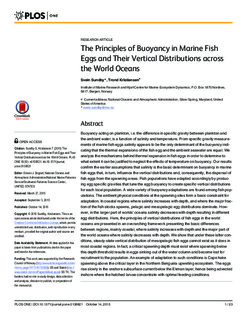| dc.description.abstract | Buoyancy acting on plankton, i.e. the difference in specific gravity between plankton and the ambient water, is a function of salinity and temperature. From specific gravity measurements of marine fish eggs salinity appears to be the only determinant of the buoyancy indicating that the thermal expansions of the fish egg and the ambient seawater are equal. We analyze the mechanisms behind thermal expansion in fish eggs in order to determine to what extent it can be justified to neglect the effects of temperature on buoyancy. Our results confirm the earlier assumptions that salinity is the basic determinant on buoyancy in marine fish eggs that, in turn, influence the vertical distributions and, consequently, the dispersal of fish eggs from the spawning areas. Fish populations have adapted accordingly by producing egg specific gravities that tune the egg buoyancy to create specific vertical distributions for each local population. A wide variety of buoyancy adaptations are found among fish populations. The ambient physical conditions at the spawning sites form a basic constraint for adaptation. In coastal regions where salinity increases with depth, and where the major fraction of the fish stocks spawns, pelagic and mesopelagic egg distributions dominate. However, in the larger part of worlds’ oceans salinity decreases with depth resulting in different egg distributions. Here, the principles of vertical distributions of fish eggs in the world oceans are presented in an overarching framework presenting the basic differences between regions, mainly coastal, where salinity increases with depth and the major part of the world oceans where salinity decreases with depth. We show that under these latter conditions, steady-state vertical distribution of mesopelagic fish eggs cannot exist as it does in most coastal regions. In fact, a critical spawning depth must exist where spawning below this depth threshold results in eggs sinking out of the water column and become lost for recruitment to the population. An example of adaptation to such conditions is Cape hake spawning above the critical layer in the Northern Benguela upwelling ecosystem. The eggs rise slowly in the onshore subsurface current below the Ekman layer, hence being advected inshore where the hatched larvae concentrate with optimal feeding conditions. | nb_NO |

